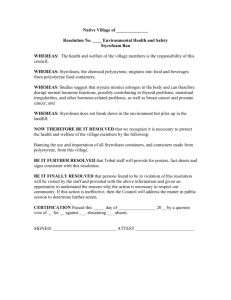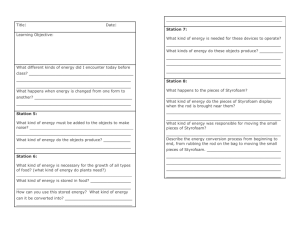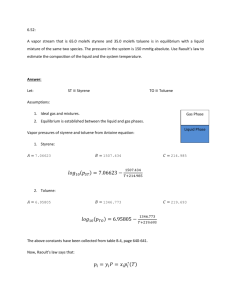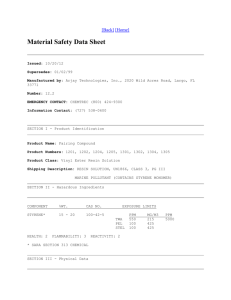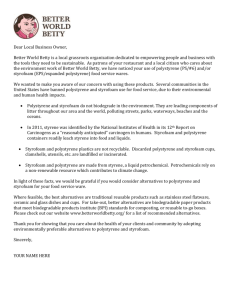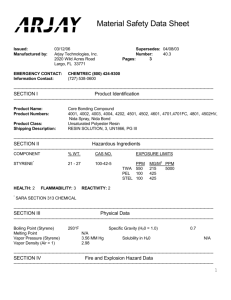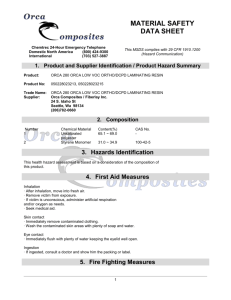styrofoam – the silent killer
advertisement
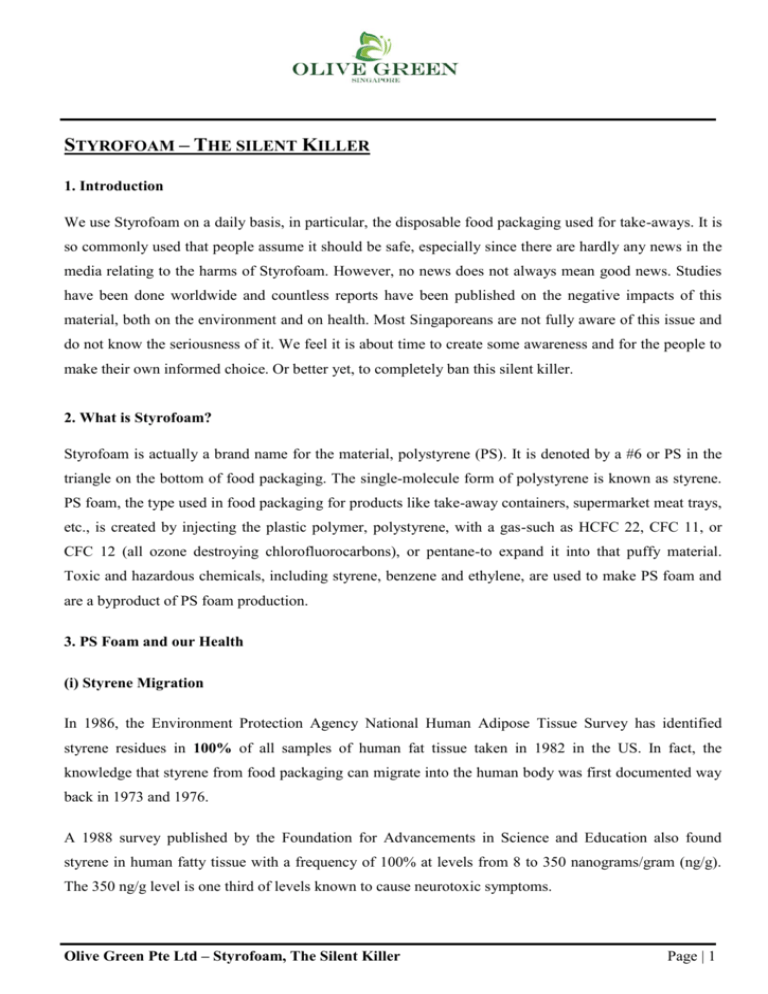
STYROFOAM – THE SILENT KILLER 1. Introduction We use Styrofoam on a daily basis, in particular, the disposable food packaging used for take-aways. It is so commonly used that people assume it should be safe, especially since there are hardly any news in the media relating to the harms of Styrofoam. However, no news does not always mean good news. Studies have been done worldwide and countless reports have been published on the negative impacts of this material, both on the environment and on health. Most Singaporeans are not fully aware of this issue and do not know the seriousness of it. We feel it is about time to create some awareness and for the people to make their own informed choice. Or better yet, to completely ban this silent killer. 2. What is Styrofoam? Styrofoam is actually a brand name for the material, polystyrene (PS). It is denoted by a #6 or PS in the triangle on the bottom of food packaging. The single-molecule form of polystyrene is known as styrene. PS foam, the type used in food packaging for products like take-away containers, supermarket meat trays, etc., is created by injecting the plastic polymer, polystyrene, with a gas-such as HCFC 22, CFC 11, or CFC 12 (all ozone destroying chlorofluorocarbons), or pentane-to expand it into that puffy material. Toxic and hazardous chemicals, including styrene, benzene and ethylene, are used to make PS foam and are a byproduct of PS foam production. 3. PS Foam and our Health (i) Styrene Migration In 1986, the Environment Protection Agency National Human Adipose Tissue Survey has identified styrene residues in 100% of all samples of human fat tissue taken in 1982 in the US. In fact, the knowledge that styrene from food packaging can migrate into the human body was first documented way back in 1973 and 1976. A 1988 survey published by the Foundation for Advancements in Science and Education also found styrene in human fatty tissue with a frequency of 100% at levels from 8 to 350 nanograms/gram (ng/g). The 350 ng/g level is one third of levels known to cause neurotoxic symptoms. Olive Green Pte Ltd – Styrofoam, The Silent Killer Page | 1 Styrofoam drinking leach Styrofoam into the liquids they contain. The cups apparently lose weight during the time they are in use. The migration of styrene from a polystyrene cup containing cold or hot beverages has been observed to be as high as 0.025% for a single use. That may seem like a rather low number, until you work it this way: If you drink water, tea, or coffee from polystyrene cups four times a day for three years, you may have consumed about one Styrofoam cup-worth of styrene along with your beverages. It has been shown that styrene monomer can affect the quality of food products at known migration levels, and over 50 percent of the migration of residual monomer occurs within twenty-four hours (within the normal shelf life of many food products). Styrene migration has been shown to be dependent on a few factors: fats content, acidity, heat, presence of ethanol and presence of vitamin A. Fats content: Styrene is soluble in oil and fat. The higher the fats content of the food, the higher the migration of styrene into the food. Entrees, soups, or beverages that are higher in fat (like coffee with milk and fried noodles) will suck more of the styrene out of the polystyrene container. Acidity: Acids raises the styrene migration rate. Studies showed that tea with lemon produced the most marked change in the weight of the foam cup. Heat: Studies have found that styrene tends to migrate more quickly when foods or drinks are hot. However, meat or cheese bought from the supermarket on a clear-plastic-wrapped polystyrene tray is also readily picking up styrene from the foam container. Presence of ethanol: Styrene is soluble in ethanol, commonly found in alcoholic beverages. For instance, red wine will instantly dissolve styrene. A 1985 Cuban study noted migration of styrene from low and high-density polyethylene into milk, yogurt and alcohol solutions. This means that ingestion can take place by using polystyrene cups to drink beer, wine and mixed alcoholic drinks. Presence of Vitamin A: Most interesting is the degradation of food that contains vitamin A (betacarotene). In packaged foods with the addition of heat (such as microwave temperatures), vitamin A will decompose and produce m-xylene, toluene, and 2,6-dimethylnaphthalene. Toluene will aggressively dissolve polystyrene. This renders polystyrene as an unsuitable package for containing or microwaving products that contain vitamin A. Olive Green Pte Ltd – Styrofoam, The Silent Killer Page | 2 (ii) Health Effects of Styrene Once styrene gets into your food or drink—and then into you—what does it do? Studies suggest that styrene mimics estrogens in the body and can therefore disrupt normal hormone functions, possibly contributing to thyroid problems, menstrual irregularities, and other hormone-related problems, as well as breast cancer and prostate cancer. The estrogenicity of styrene is thought to be comparable to that of Bisphenol A, another potent estrogen mimic from the world of plastics. Low levels of Bisphenol A have been found to reduce the sperm count in rats. The official word on styrene and cancer- Styrene is considered a possible human carcinogen by the World Health Organization's International Agency for Research on Cancer. Evidence already shows that styrene causes cancer in animals. According to a Foundation for Achievements in Science and Education fact sheet, long-term exposure to small quantities of styrene can cause: low platelet counts or hemoglobin values; chromosomal and lymphatic abnormalities; neurotoxic effects due to accumulation of styrene in the tissues of the brain, spinal cord, and peripheral nerves, resulting in fatigue, nervousness, difficulty sleeping, and other acute or chronic health problems associated with the nervous system. Chronic exposure to high levels of styrene can cause health effects such as liver and nerve tissue damage. Because many of these effects can be more pronounced on developing bodies, extra caution is advisable for women who are pregnant (or considering becoming so) and for prepubescent children. Since alcohol crosses the placental barrier this could be the vehicle of transmission of styrene monomer into the foetus, and could explain why small children have traces of styrene monomer in their tissues even though they have never been exposed to the monomer directly. In a study of 12 breast milk samples from New Jersey, Pennsylvania, Louisiana, 75% were contaminated with styrene amongst other hazardous chemicals. There have not yet been enough studies to know whether the relatively small amounts of styrene from PS foam cups and food containers are enough to cause health effects. But the fact remains that ingested Olive Green Pte Ltd – Styrofoam, The Silent Killer Page | 3 styrene will build-up in human tissue and we know from studies of other chemicals that long-term, constant exposure to small amounts of foreign substances, especially those that mimic hormones, causes problems. So, it makes sense to avoid polystyrene as much as possible. 4. PS Foam and our Environment Besides health issues, PS foam is also a direct threat to our environment. Plastics are made of petroleum, a non-renewable resource that requires new fossil reserves to be extracted all the time. Because fossil fuels take millions of years to form, they are a finite and, ultimately, an exhaustible energy resource. The chemicals involved in production of PS foam are among the top 25 toxic air pollutants in terms of the total amount released into the environment each year. In addition, scientists indicate that 5% of the earth's ozone layer has already been damaged due to ozone destroying compounds like CFCs. Many manufacturers label their PS foam containers as "CFC free," but read the fine print. Usually these labels say the PS foam is no longer made with "fully halogenated" chlorofluorocarbons, which means that the CFC used previously has likely been replaced with an HCFC, which, though less damaging to the ozone layer, is still a CFC and an ozone destroyer. Furthermore, plastic polymers never fully biodegrade. Instead they photo degrade into dust, and in bodies of water, that dust can absorb other toxins such as polychlorinated biphenyls (PCBs) and the pesticide DDT, which is still used in developing countries. The toxins are concentrated even more strongly in this toxic dust, which is consumed by the fish that humans eventually eat. Since PS foam do not breakdown easily, it creates the problem of ‘white pollution’. PS foam boxes and cups which are littered in our environment stays in our environment for a long time. They fragment into small pieces and are both an eyesore and a hazard to wildlife. As reported in The Straits Times recently, PS foam littering is a serious problem along our coastlines. In the sea, PS foam leach toxins and some animals, like birds and turtles, mistake them for food causing them to die of malnutrition and suffocation. Conclusion Based on the documented findings and analyses done, it is for certain that styrene in Styrofoam poses a definite health risk. Though its ill effects cannot be seen in the short run or in immediate cases liken to that of pesticides, it will and can cause a host of health problems in the later years. Like arsenic, styrene Olive Green Pte Ltd – Styrofoam, The Silent Killer Page | 4 can poison a person on a daily basis. It accumulates in the body and eventually, the person may not even know the real cause of his demise. Surveys done have shown that hawkers know about the ills of Styrofoam but the appalling truth is that they simply do not bother since they are not the ones eating from these boxes. Futhermore, it is rock bottom cheap as a cost to them. Is this to be condoned when we are the ones supporting their trade? In my opinion, the relevant authorities had overlooked and underestimated the very nature of Styrofoam which plays such a crucial role in our lives today. Are we suppose to wait for a case of styrene poisoning before we begin to delve deeper into this topic only to realise that we might have consumed a bit too much in our lifetime? There are already so many cancer causing agents present in all aspects of our lives today, from the air we breathe to the food and water we drink. It only makes good common sense to avoid anymore of these once we are in doubt. We should emulate what the rest of the world has already done. Countries like Japan, Italy, Taiwan, China, the UK and US have all begun this protest against Styrofoam, both for our health and for environment. If the developed nations have already recognised the ills of this product, which they had help create years ago, I don’t see why we are procrastinating still. By my efforts, I can only make a difference… but together as a bonded community, we can make a change. It is now or never. Olive Green Pte Ltd – Styrofoam, The Silent Killer Page | 5 Bibliography 1. "Are Styrene Food and Beverage Containers A Health Hazard?," Institute for Local Self-Reliance, Washington, DC, August 15, 1990. 2. Brian Lipsett, "Areas of Expertise Pertaining to McDonald's Corp.." 3. K. Figge, "Migration of Additives from Plastic Films into Edible Oils and Fat Stimulants," Food Cosmet Toxicol, December 10, 1972, Vol. 6, pages 815 828. 4. B.J. Dowty, J.L. Laseter, and J. Storet, "Ther Transplacental Migration and Accumulation in Blood of Volatile Organic Constituents," Pediatric Research, Vol. 10, pages 696-701, 1976. 5. "Polystyrene Fact Sheet," Foundation for Advancements in Science and Education, Los Angeles, California 6. J.L. O'Donoghue, Neurotoxicity of Industrial and Commercial Chemicals: Vol. 2, CRC Press, Inc., Boca Raton, Florida, 1985, pages 127-137. 7. N.S. Zlobina, A.S. Izjumova, and N.Ju. Ragul'e, "Effects of Low Styrene Concentrations On The Specific Functions of the Female Organism" (human and white rat), Gigiena truda i professional'nye sabolenavija, Moskva, USSR, December 1975, No. 12, pages 21-25. 8. Kirk-Othmer, "Physical Properties of Styrene Monomer," Encyclopedia of Chemical Technology, Vol. 21, page 771. 9. Joseph Miltz, "Migration of Low Molecular Weight Species From Packaging Materials: Theoretical and Practical Consideration," Michigan State University, East Lansing, Michigan, July 1986. 10. Kirk-Othmer, "Latex Technology," "Water Solubilities of Some Commercially Important Monomers," Encyclopedia of Chemical Technology, Vol. 14, page 83. 11. M. Garcia Melian, E. Bernal Torres, and Valera Diaz, "Total Migration From Plastic Yoghurt Pots," Revista Cubana de Hygiene y Epidemiologia, Sancti Spiritus, Cuba, Vol. 23, No. 4, pages 441-446, 1985. 12. D. Macias Matos, Z. Vidland Candebat, Y. Prieto Gonzales, and M. Fontaine Semanat, "Sanitary Evaluation of Containers or Milk Products." 13. George Baggett, "Styrene Migration Into Human Adipose Tissue," August, 7, 1990. 14. Dora B. Gold stein, M.D., "Absorption, Distribution and Elimination of Ethanol," Pharmacologies of Alcohol, Oxford Press, 1983. 15. Joseph Miltz, "Migration of Low Molecular Weight Species From Packaging Materials: Theoretical and Practical Consideration," Michigan State University, East Lansing, Michigan, July 1986. 16. Websites: - www.ecocycle.org/styrofoam.htm - www.grinningplanet.com/2005/11-01/styrofoam-cups-article.htm - www.ourstolenfuture.org/NewScience/reproduction/sperm/2001sakaueetal.htm - www.thegreenguide.com/reports/product.mhtml?id=44&sec=2 Olive Green Pte Ltd – Styrofoam, The Silent Killer Page | 6 Article The Straits Times Sep 15, 2007 Styrofoam makes up bulk of trash along S'pore's coast UNLIKE most parts of the world where cigarettes contribute most to the rubbish collected on beaches, the bulk of trash picked up on Singapore's coast comes from styrofoam. The International Coastal Cleanup Singapore which is the only concerted effort by volunteers here to analyse the kinds of trash that local shores collect, has found this material increasing in quantity over the last five years. Mr N Sivasothi, coordinator of the ICCS since 2000, says this is of concern. 'Styrofoam is potentially much more damaging because it can fragment badly, whereas cigarette butts stay whole,' he said. 'The overwhelming problem we have is plastic consumer items in the sea. As it breaks down, the chemicals that leach from it can be toxic.' 'Studies on birds in the Pacific Ocean have also shown wildlife dying of malnutrition from mistaking this and other kinds of plastics for food,' he added. Preliminary data from this weekend's coastal clean up saw styrofoam caking up the coast lines of both mangrove swamps and beaches. Olive Green Pte Ltd – Styrofoam, The Silent Killer Page | 7

